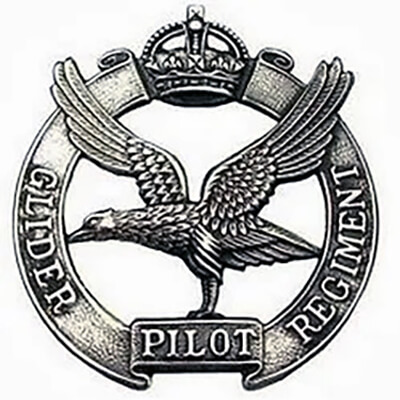| Page Created |
| January 13th, 2024 |
| Last Updated |
| November 8th, 2024 |
| Country |
 |
| Additional Information |
| Unit Order of Battle Commanders Operations Equipment Multimedia Sources Biographies |
| Badge |
 |
| Motto |
| Nihil est Impossibilis |
| Founded |
| December 21st, 1941 |
| Disbanded |
| 1957 |
| Theater of Operations |
- Norway
- Sicily
- France
- The Netherlands
- Germany
| Organisational History |
The Glider Pilot Regiment was responsible for manning the British Army’s military gliders and actively participates in various operations across the European theatre. Established in 1942, this regiment is operational until its disbandment in 1957.
Motivated by the German military’s innovative use of airborne formations, particularly during the 1940 Battle of France, the Allied governments decide to establish their own airborne units. This leads to the creation of two British airborne divisions and several smaller units. The development of the British airborne forces begins on June 22nd, 1940, under the directive of Prime Minister Winston Churchill, who instructs the War Office to explore the potential of a 5,000-strong parachute troop corps.
The Central Landing Establishment forms on June 21st, 1941, at Ringway airfield near Manchester. Initially focusing on parachute troop training, it also investigates the use of gliders for troop transportation. This initiative involves cooperation between the Royal Air Force and the Army, with Squadron Leader Louis Strange and Major J.F. Rock tasked with assembling potential glider pilots. They seek individuals with pre-war glider flying experience or those keen to learn.
In September 1941, a decision is made: all glider pilots are required to adhere to Royal Air Force selection procedures and complete standard Royal Air Force elementary flying training using powered aircraft before transitioning to gliders. The establishment of the Glider Pilot Regiment receives official approval on December 21st, 1941, and it is formally authorised by Royal Warrant on February 24th, 1942, the Glider Pilot Regiment joins the newly formed Army Air Corps, alongside the Parachute Regiment, wartime Special Air Service, and the Air Observation Post squadrons of the Royal Artillery.
Provided with outdated Armstrong Whitworth Whitley bombers and a few Tiger Moth and Avro 504 biplanes for towing, the unit begins to work with the War Office and Air Ministry to develop several military glider types, including the General Aircraft Hotspur, General Aircraft Hamilcar, Airspeed Horsa, and Slingsby Hengist. While waiting for these designs to be realised, the unit improvises with existing resources.
A Glider Training Squadron is established, operating under the command of Squadron Leader H E Hervey, MC. This squadron is tasked with the crucial role of training and preparing glider pilots for their unique and challenging airborne missions. The Glider Training Squadron sees the conduct of initial test-flights using Swallow light aircraft, modified to emulate gliders. These are towed using various tow-ropes to experiment with different configurations. The squadron appeals for civilian glider donations, receiving its first four in August, three of which originate from pre-war Germany. These gliders are crucial for training instructors, pilots, and ground crews, despite frequent accidents due to hemp tow-rope failures, an issue later resolved with nylon tow-ropes from the USA.
The first group of 40 volunteers successfully completes their training in March 1942. Following this, they engage in a series of small-scale glider exercises with troops. These exercises prove invaluable in developing and refining basic glider operation techniques.
On September 26th, 1942, the squadron demonstrates its capabilities with parachute drops and glider towing observed by Prince George, Duke of Kent. This event is followed by further training exercises, reflecting a more structured approach to airborne warfare.
In the early stages, disputes arise between the Royal Air Force and the Army over the control of glider pilots. The Royal Air Force considers gliders as aircraft under their jurisdiction, while the Army views pilots as integral to the combat units they transport. A compromise is reached, allowing pilots to be recruited from the Army but trained by the Royal Air Force.
Army volunteers undergo Royal Air Force selection before training as light aircraft pilots over a 12-week course, followed by a further 12 weeks of glider training on the General Aircraft Hotspur, and then specialised training for the Airspeed Horsa.
The War Office determines that glider pilots, once landed, are to train and operate as soldiers. They receive comprehensive training in the use of all weaponry employed by airborne troops. Every glider pilot, whether an officer or a non-commissioned officer (NCO), is expected to exhibit exceptional levels of intelligence, initiative, and discipline. Upon completion of their training, these pilots are distinguished by the Army Flying Badge, signifying their specialised skills and qualifications in airborne operations.
The Army Air Corps undergoes restructuring in 1949, leading to the formation of the Glider Pilot and Parachute Corps.
In 1957, the Glider Pilot Regiment and the Air Observation Post squadrons amalgamate to form the modern Army Air Corps.
